In an attempt to better document the sharp, rusty sliver of the American underground that worked its way through the protective coating of my cold, slowly-beating heart 20-some years ago, I’ve given myself the task of tracking down and interviewing all of my heros in the world of zines. Today’s interview is with Eric Nakamura, the man behind the ever-evolving juggernaut known as Giant Robot.
MARK: I believe I’ve heard that you grew up in the Sawtelle area of Los Angeles. Is that correct?
ERIC: Yes, my grandmother lived just down the street from where I’d eventually open my Giant Robot shops. My parents and I lived in the area too for a while. It’s where I went to daycare. I also attended a Japanese school there, and went to a Buddhist Temple there… After years of it being called “Little Osaka,” the area is now officially called “Sawtelle Japantown” with two official signs, and an upcoming freeway marker as well.
MARK: For people who might not be familiar with the concept, Japanese school is something that you’d attend on evenings and weekends, in addition to “regular” school, a kind of supplemental educational program for kids of Japanese descent, right?
ERIC: Yes. For a while I attended after school. It was an extra hour of class, and it was a drag. Then I was able to switch to Saturdays, which was better, even though there were cartoons that I missed out on. Ultimately, it was worth it. As a result of going, I speak some Japanese and understand it too.
MARK: So, you didn’t speak Japanese at home?
ERIC: That’s right. We only spoke English at home.
MARK: So, what was Sawtelle like when you were a kid?
ERIC: It was definitely more quiet than it is today. I’d like to think it was more neighborly too. And it was definitely more Japanese American and Latino. Today, it’s a heavy business area, with high real estate prices. And the owners of most of the shops aren’t local, like they were when I was growing up in the area. I miss that a little, and it’s gone forever.
MARK: Would I be right to assume that, when you were young, there were quite a few stores in Sawtelle selling robot toys and things that we’d consider Japanese pop culture items?
ERIC: There were a few. Pop culture wasn’t quite so defined back then. It was just “stuff” to me at the time. The stores carried awesome robot toys and imported stationery, like cool pencil cases and erasers, but they sold rice bowls too.
MARK: Do you remember the first robot toy that you really loved?
ERIC: Ha, yes. Raideen. A five inch-tall die-cast figure. I still have it. I think it’s the only childhood toy that I still own… It’s quite beat up.
MARK: What made this Raideen figure so great?
ERIC: It was die-cast metal, and it folded up into a bird, which was cool… This was pre-Transformers…. And it shot its fists as projectiles. Quite cool for a toy in the ‘70s!
MARK: Were you able to keep his fists this whole time too?
ERIC: Ha. It’s weird, but, yes. Somehow Raideen made it through the decades intact. He even changed hands once, but eventually he made it back to me, and his fists were still with him.
MARK: As a young white kid growing up in the American south, my exposure to Japanese pop culture, with the exception of the occasional Godzilla movie, was limited to Ultraman, which, for some reason, was relatively pervasive back in the ‘70s. I suspect, for a lot of us in my generation, Ultraman was the “gateway drug” that led to further exploration. It may seem like an odd question, but I’m curious to know if it’s something that you ever looked into… how Ultraman came to find its way onto American television in such a big way.
ERIC: No, I don’t have any idea. I can only guess that it was the sheer quantity of episodes, and the fact that there were tons of monsters. I watched it too, but there were other shows that seemed equally pervasive, at least here, in Southern California… Ultraman was there, but didn’t really stick out to me at the time.
MARK: What stuck out to you? What was I missing out on?
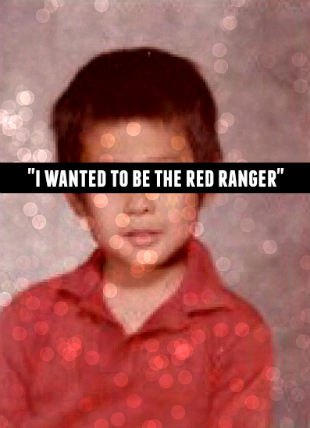 ERIC: Kikaida was quite great. It’s still huge in Hawaii. I believe they continue to do a Kikaida Day every year. It’s from the ‘70s! And then there was Go-Ranger, the first, and original, Power Ranger iteration. I watched that… I wanted to be the Red Ranger. Right now, there’s a revival of the Sentai (the colorful group of heroes), and it’s great to see the original Red Ranger coming back for the next generation.
ERIC: Kikaida was quite great. It’s still huge in Hawaii. I believe they continue to do a Kikaida Day every year. It’s from the ‘70s! And then there was Go-Ranger, the first, and original, Power Ranger iteration. I watched that… I wanted to be the Red Ranger. Right now, there’s a revival of the Sentai (the colorful group of heroes), and it’s great to see the original Red Ranger coming back for the next generation.
MARK: Have you ever lived outside of Los Angeles?
ERIC: I was born in LA, and I’ve lived here most of my life, with a few exceptions. I lived in San Francisco for a very short while. I’d started college at Santa Monica City College, then I transferred to San Francisco State for a semester. After that, I went to UCLA.
MARK: What did your folks do for a living when you were young?
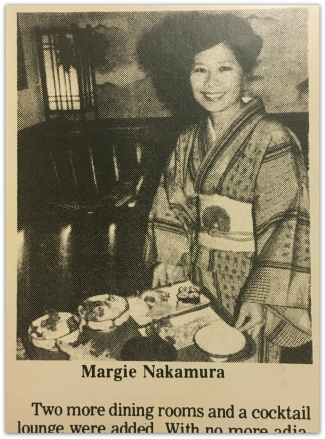 ERIC: My father did small residential building contracting, and my mother owned a restaurant.
ERIC: My father did small residential building contracting, and my mother owned a restaurant.
MARK: I didn’t realize that your family had a restaurant. Did that experience come in helpful when you were running the Giant Robot restaurant?
ERIC: Yeah, I guess… Actually, I probably should have listened to the many “Don’t open a restaurant” warnings that I heard from her over the years… I wouldn’t do it again.
MARK: Did your folks try to talk you out of opening the Giant Robot restaurant?
ERIC: Not really… The rent was low, so it was a great way to learn and experience something new.
MARK: How long was the restaurant open, and what did you learn from the experience?
ERIC: It was open for seven years, and I learned not to ever do it again. Restaurants don’t operate like retail shops. I didn’t know that, for instance, when people quit, they don’t give you two weeks notice. And machines, like refrigerators, stoves, and overhead exhaust systems, breakdown quickly, and for no apparent reason. Restaurants only work when you have tremendous volume, and you need to have a super-committed staff, which is tough to find.
MARK: Were one, or both of your parents first generation from Japan?
ERIC: My mother is first generation from Japan. I think she moved to the U.S. in the early ‘50s. My father, however, was born in California.
MARK: When did you first let your parents see a copy of Giant Robot, and what did they make of it?
ERIC: I remember, as it got going, they didn’t think much of it. Then, when they did see a glimmer of possibility, I remember them saying that, while they didn’t have the skills to help me, they wanted me to know that they were supportive.
MARK: I’ve always been fascinated by the early LA punk scene, and I was wondering if maybe, given your age, you were at all involved, as I think a lot of people came to zines that way in LA through publications like Slash.
ERIC: I was into punk rock, but I wasn’t in the first wave. I’d maybe classify myself as a second generation punk rock fan. Black Flag era. But I didn’t dress the part. I liked metal too, and enjoyed both BMX and skateboarding.
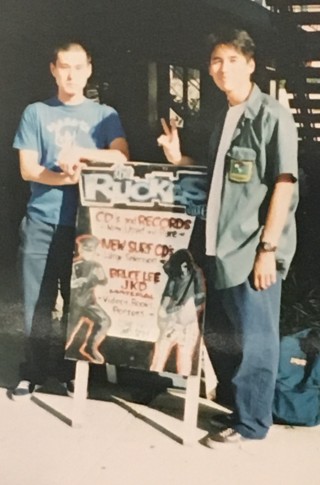 MARK: What was the best show you ever saw?
MARK: What was the best show you ever saw?
[right: Co-editor Martin Wong and Nakamura outside an early Giant Robot issue release party at the old Ruckas store in West Los Angeles. Chris Ashford, the owner of Ruckas, sold Giant Robot from the beginning. He also put out 7″ singles by The Germs, Dils, Eyes, etc.]
ERIC: I can’t recall one being above everything else, but I was glad to be at just about every show I went to. Maybe it was a super early Soundgarden show. It’s not exactly punk rock, but still great. How about yours?
MARK: Maybe my first Ramones show, because of the trajectory it sent me on. All of their shows were exactly the same, but the first time I saw them was something special. I’ve seen a lot of great shows, though. The most memorable might have been the Violent Femmes at Carnegie Hall in about ‘85. Carnegie Hall was not prepared. They had to keep shutting the show down. For a young kid, it was thrilling.
ERIC: I saw Fishbone at Fender’s in 1986. That was a fun show. The weird part is, there was a zine called I Was a Teenage Filipino Skinhead that published a story about it. It wasn’t mentioned explicitly, but the writer/artist, Greg Narvas, had to have been at that exact show. As it turned out, a good friend of mine was also at that show and got into an altercation outside!
MARK: Did your friend’s altercation make it into Narvas’s story?
ERIC: No. It was behind the scenes evidently. It included skinheads, roadies, and a promoter getting punched in the face.
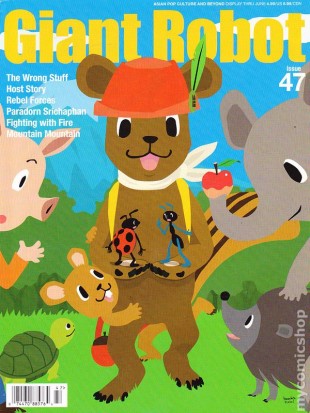 MARK: Do you recall the first zine you ever saw?
MARK: Do you recall the first zine you ever saw?
ERIC: No, nothing really stands out as being the first. I’d like to say it was Flipside, but, really, I can’t recall. It must have been something that I saw at a record store in LA, though. That would have been the only outlet for zines in my area… I wish I could tell you that the first zine I saw was instrumental in my upbringing, but it wasn’t.
MARK: Do you remember the first time you saw Factsheet Five? Was it before or after you started Giant Robot?
ERIC: I’m thinking I saw it afterwards. It would have been the R. Seth Friedman era. We were quite positively reviewed. Both Factsheet Five and Zine Guide were places that we got a lot of support. I think Zine Guide did some kind of zine ranking based on votes and we were often near the top.
MARK: Was it at all a surprise to you when you discovered just how enormous the zine universe was? Did you have any idea, when you started Giant Robot, what kind of community that you’d joined? I mean, I’ve talked with a lot of people who started zines back in the day and, quite often, I hear from them that they didn’t have any idea, when they set out, just what they’d gotten themselves into… They’d just tried to start a magazine, without realizing that they’d joined a subculture.
ERIC: In LA, zines were behind for some reason. The SF Bay area had a strong zine culture, but, being from LA, I didn’t feel like we were part of that “scene.” Strange as it sounds, it still felt like we were doing our thing in a small community. Maybe it’s because our topics were so different. That’s just what I felt. In reality, I suppose we were part of this giant world, but it didn’t feel that way early on.
MARK: Was Giant Robot your first foray into publishing?
ERIC: I put out a newsletter at my Japanese school. This would have been in ‘82 or ‘83. It was just stapled sheets. I wish I could see that today. I talked massive shit about people.
MARK: Was it published anonymously?
ERIC: Yes. It was a big deal at the time. There was an investigation by the administration into who was putting it out. There were individual interviews of each student. I’m sure they knew it was me and another kid. Ultimately, though, freedom of speech won out. Looking back, it shouldn’t have been that big of a deal. They should have been happy that students wanted to create some type of culture at the school. But I’m sure the school hasn’t changed a bit since I went there.
MARK: When you say that you talked “massive shit” about people, what do you mean? Can you give me an example?
ERIC: About the teachers. I suppose that wouldn’t be great fodder for an official school paper. There were positive things too, like talking about how there should be a paper for the students. Imagine if, instead of cracking down, they‘d encouraged us students to work on a bilingual newsletter. It could have been a great learning tool. But, frankly, that would have been too forward thinking for them.
MARK: How many issues did you put out, and did you solicit stories from your fellow students… or was it just you and your one friend?
ERIC: There was just a single issue. And, yes, it was just me and one other student that were involved.
MARK: What were the circumstances surrounding the founding of Giant Robot? Do you remember where the idea was first hatched?
ERIC: I knew, from working at Larry Flynt Publications, that it didn’t take a lot of people to make a magazine. I worked on a video game magazine that was incredibly understaffed, and yet we got a publication out every month. That was right out of college… And, at the same time, I was thinking about the fact that there weren’t really any publications that I identified with, especially as an Asian American. There was literally nothing. I’d seen some independent Asian American newspapers while at UCLA, so there was some media out there, but that was still governed by the school. There wasn’t anything independent. And I’d been doing photography for years, and I had to write for the video game magazine, so I knew I had the skillset to handle the editorial duties on an indie level.
MARK: I didn’t realize that you were “in the industry,” working for Flynt, when you started Giant Robot… So were you thinking about it as a potential business right from the start, or was it more a labor of love at the beginning, a hobby?
ERIC: Giant Robot was a definitely the latter! It was a zine, but there was great energy behind it. It was meant to be something substantial. I hoped for it to be a resource. I think that first issue was 64 pages with a price of $2.
MARK: What was your initial focus in that first issue?
ERIC: I’m not sure if there was a clear focus. I just wrote about things that I was into at the time: watching Sumo wrestling, listening to The Boredoms, and watching films by Jon Moritsugu.
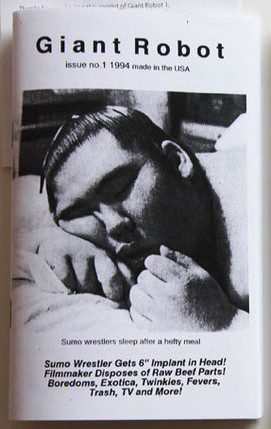 MARK: Were you able to get any interviews for that first issue? Did you try?
MARK: Were you able to get any interviews for that first issue? Did you try?
ERIC: Yes, for that first issue, I had some words with The Boredoms, and a lengthy interview with Jon Moritsugu. I took the idea of a zine seriously and wanted to employ what I thought to be good journalistic practices.
MARK: Was that part of the appeal of having a zine, having a reason to reach out to these people that you respected?
ERIC: That definitely made it easier. If you were a fan with a zine that people respected, you could often interview your heroes.
MARK: How were you handling distribution at the outset? Were you just selling copies of Giant Robot to your friends, or did you have it for sale at record stores around LA?
ERIC: I tried to take it to stores, but it would get rejected! It was $2, and something totally different, but I guess they didn’t think that it would sell.
[above: Co-editor Martin Wong squatting with a box of Giant Robots in Seattle, on the way to their first zine fest.]
MARK: How did you eventually convince stores to carry it?
ERIC: It took a few issues to really get out there. At the time, I thought distribution was the key, so I struggled to find a distributor. With the third issue, we went full-size, so it was an easier sell at that point… I’m not so sure if that’s the way to go today, though.
MARK: Who did you distribute through?
ERIC: Tower, and I think Fine Print as well. There might have been more than that early on, but I don’t recall. Distribution was something that was both great and detrimental to print publications. Both ends. If I were trying to do this today, I would probably stay away from distributors entirely.
MARK: So you never got screwed by Desert Moon? They went out of business owing us a lot of money. And we weren’t alone.
ERIC: Fine Print, Desert Moon, Tower (to an extent), Big Top Distribution Services – IPA all went down owing us money. We got paid pennies on the dollar in each case. I’m sure there were more… They all began with great intent. Fine Print was willing to take our zine into more shops, and so forth. Then Big Top arose out of Fine Print’s ashes, and promised a lot, and got the trust, not just from us, from from so many publishers. Then, poof, one day their doors were locked up and their phones were disconnected. They just disappeared. Then Big Top became Independent Press Association, I believe. Then they folded. Of course, we didn’t know that any of this was going to happen at the time. It just kept unfolding. I recall getting an email from an employ of one of these distros, just a day or so after they went out of business, soliciting their consulting services. They said they could help me with distribution… Balls of steel.
MARK: It’s hard to believe that so many of them could fail, given the distribution model… I mean, we, as publishers, took most of the risk, right?
ERIC: Yeah, I’m guessing people don’t know how unfair magazine distribution really is for a publisher. It’s a fucked-up business, and it only really works for gigantic publishers. I don’t think most people know this, but, when an issue of your magazine is stolen from a store 1,000 miles away, you, as the publisher, pay for it. That wouldn’t work in any other industry, but we’re expected to accept it. If I bought a bike and it got stolen or lost, that would be my own tough shit. But, in magazine land, I’d be able just screw the bike company. What the fuck kind of system is that?
[above: Stacks of Giant Robot #4 in the Nakamura family home.]
MARK: And let’s not forget that we’re just supposed to take the word of the retailer as to how many copies were sold…
ERIC: Right. And, on top of it, we have to pay to have the issues of our zine shipped from the distribution warehouse to that shop, wherever it is? They call it a “reship” fee. You also, like you’re saying, get no proof of sales. It’s by affidavit, so you have no choice to believe them. You also get paid something like 210 days once the off sale date has kicked in. So, basically, you get paid something like 9 months after you paid for the printing and shipping – with so many little fees added in. It’s fucked up gangster shit. Then, you find out that your distributor, who hasn’t paid you for maybe four or five issues (if you were bi-monthly), went out of business, and now you’re not getting paid at all. It’s what killed Punk Planet.
MARK: So, do you think you could have made it without a distributor?
ERIC: I sometimes think, if I just held on to saying “fuck distributors,” it’s possible it would have turned Giant Robot into a much stronger company… We’d have been super streamlined.
I should also add that I could be wrong about a few things. And there were probably some good things that I’m not mentioning. At the same time, though, I’m probably also omitting many more fucked-up ways that distributors fucked Giant Robot. The subject of distribution, more than anything else, brings up bad memories for me. And I regret not having done more to fix the situation. Why did we (all of us small press folks) ever work with them? We should have made the industry work with us. They eventually would have.
MARK: Speaking of good things in the world of zine distro, it was Tower’s Doug Biggert who recommended that I interview you for this series.
ERIC: Doug really was the patron saint of zines and distribution. And I’m not just saying that because he introduced us. In the end, Tower did things decently. They took Giant Robot when it was still digest size. We’d just put out an issue or two when Doug said they’d take us. Yes, we still got stiffed out of our money in the end, so we got screwed by them too, for the sake of consistency, but they weren’t evil. And Tower Japan, which is still there, continues to be a huge connection that I have to Japan. Many Japanese artists, designers, and creatives who I meet say the greatest things about Giant Robot and how they waited for new issues at Tower Shibuya. That’s means a lot.
MARK: You mentioned that Giant Robot came out of a desire on your part to have a magazine that you could identify with as an Asian American. Were you at all surprised to find that a lot of your readers weren’t Asian American?
ERIC: Not really. I didn’t think of it as a product for a certain type of person. I just wanted it to celebrate Asian popular culture.
MARK: Are there subjects you stayed away from?
ERIC: Well, it wasn’t meant to be steeped in Asian American politics, which, as interesting as it is for me, would put most people to sleep.
MARK: Have you, as a result of your work, found any evidence of Asian American zines that existed before Giant Robot?
ERIC: Yes, but I only know of one. Gidra was a political zine run by Asian Americans from ‘69 – ‘74 or ‘75. It was political, as the era dictated, but it had great comics and illustrations too. It was more like a newspaper. There were surely others, but, in the punk rock era, maybe not. A bunch followed us though.
MARK: Have you talked with the folks who put out Gidra?
ERIC: Yes. I keep in touch with one of the founders. I co-teach an Asian American zines class at Pitzer College and I have invited one of the founders,Mike Murase to speak. He’s quite great, and maybe under-appreciated. Another, Duane Kubo, paid me a ridiculous compliment and said if I were around during their time, I’d have been part of Gidra.
MARK: I didn’t realize you were teaching a zine class. I know you said before that you don’t like to spend too much time looking back and reflecting on the past, but I’m curious if teaching about zines has caused to look back on your experience any differently.
ERIC: Not too much. These days, zines are practically an entirely new genre. One of the class meetings forces me to talk about Giant Robot. It feels so outdated compared to the zines of today. The only parts that are relevant are the lessons in zine making, the ages old discussion of what is “selling out,” and the business lessons learned through it all. I guess then there’s the knowing about the eras of zines and living through some of them. So I suppose it does force me to go back a bit, and the more I can illustrate about the past, the better the picture for the current students.
 MARK: Do your students produce zines as well? If so, what have you liked?
MARK: Do your students produce zines as well? If so, what have you liked?
ERIC: That’s the idea. They make two zines in the class and they also put on the Claremont Zine Fest. It’s not enough to just do work in class, but the idea is to get them out of class and do something for the community. As for zines made in class, it’s their first zines ever, so they’re made under a time restriction, but they’ve all been decent. They also have to rep those zines at the class table at their own Zine Fest.
MARK: If you had to pick one story that, in your mind, symbolized what Giant Robot was all about, what would it be?
ERIC: That’s a tough question. Giant Robot went through a lot of iterations, so there were different eras. An early one that comes to mind, however, was this large section that we published on the Yellow Power movement, which was heavily about the late ‘60s and early ‘70s Asian Americans anti-war and civil rights movement.
MARK: So you did get into politics a bit?
ERIC: Kind of, but it was still a popular culture take on it, in a way. It was interesting enough to cross into, and I don’t think was very divisive, given that it was 35 or 40 years after the fact. And it was cool… I’d like to think that those who read Giant Robot had an open mind to things. I think that open-mindedness was definitely part of our readers’ profile, which then might explain how they leaned politically. But we tried to stay away from divisive issues.
MARK: So you purposefully tried to stay away from issues that might be considered divisive?
ERIC: Politically speaking, yes, but we didn’t stay away from things that we thought could be divisive. I respect the fact that someone might not have political views that align with mine, and, since we weren’t a political magazine, we weren’t there to get into that. I would say, however, that we leaned towards the left, but, at the same time, the articles were meant to be informative and for anyone… In recent years, however, I’ve been invited to the White House by Barack Obama’s administration, and I wrote about it. I guess that could be considered divisive.
MARK: I wasn’t aware of that. What were you called to the White House for? Did Obama sign some kind of omnibus zine bill?
ERIC: It was a small business related meeting. It was more like a press conference with Barack Obama for a small business initiative. I’ve actually gone to the White House more than once. Maybe three times? Weird how I can’t remember if I went two or three times. I think it was three. Each time was a great experience. I got to wander the halls of the White House and I think I shook his hand at least a couple of times.
MARK: I think you might be the only zine person to ever be invited to the White House…
ERIC: Maybe… I’ve got to think there were probably more who were invited by the current administration, but maybe not. I have no idea who else might have went.
MARK: Of our recent presidents, my sense is that Obama is likely the most zine-friendly, but you’re the first person I’ve talked with from the scene that’s gotten an invitation.
ERIC: Barack Obama’s brother-in-law, Konrad, reads Giant Robot. And I wouldn’t doubt that the President has seen the zine. We interviewed Barack Obama’s sister Maya as well, so chances are high that he’s read that issue… And not only did I enjoy being at the White House, but it enabled me to then get some Asian American artists invited to an arts summit with Michelle Obama.
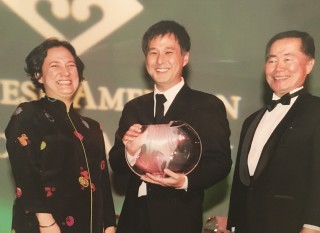 MARK: Back to the Yellow Power movement, I’m curious what you discovered about it through your research, and what kind of impact it might have had on you, if any?
MARK: Back to the Yellow Power movement, I’m curious what you discovered about it through your research, and what kind of impact it might have had on you, if any?
[right: Nakamura receiving a Japanese American National Museum “Visionary in the Arts” award from actor George Takei at the Century Plaza Hotel in Los Angeles/]
ERIC: It was an interesting topic of research and my mind was blown learning about it, but I didn’t turn into a militant civil rights activist or anything like that. I learned about the Asian American groups that fought alongside African Americans, and later fought for themselves. To this day, that might have been the most important set of articles that we published. I was thanked by a University professor who gave Giant Robot credit for reviving the interest in this movement. Our articles were assigned reading for the class… without our permission of course.
MARK: Were there other names for the zine that you considered before settling on Giant Robot?
ERIC: Yes. Great Mazinger Z. Imagine that title… It’s a robot that I liked, but simplified as Giant Robot was much better.
MARK: How did you print the first issue? Did you pay for it, or did you, like a lot of us, have a friend at Kinko’s?
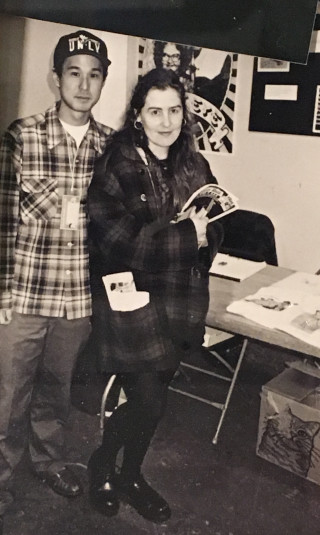 ERIC: It was photocopied, but not at Kinko’s. I think the first ones were done at an independent print shop that offered better pricing than Kinko’s. But I did have friends working in offices who had access to printers, so, for a while, printing was free. The list of where I printed for free is quite amazing. Culturally iconic places, Fortune 500 companies, and institutions, but I’ll let that rest.
ERIC: It was photocopied, but not at Kinko’s. I think the first ones were done at an independent print shop that offered better pricing than Kinko’s. But I did have friends working in offices who had access to printers, so, for a while, printing was free. The list of where I printed for free is quite amazing. Culturally iconic places, Fortune 500 companies, and institutions, but I’ll let that rest.
[right: Nakamura at an early Seattle zine fest with K Records recording artist Lois Maffeo.]
MARK: You don’t have to answer this if you don’t want to, but I’m curious as to how much of Giant Robot, at least early on, was produced within Flynt Enterprises. Was Larry an unwitting benefactor?
ERIC: None of it was done there. Not one moment. There actually wasn’t an overlap. I think Giant Robot started just months after I left Flynt.
MARK: So you were unemployed at the time?
ERIC: Yes. I can’t remember why I left Larry Flynt at that time. I was working as a busboy at my mother’s restaurant.
MARK: Were you also living at home?
ERIC: Yes. Sofa life.
MARK: So, was Giant Robot, at least at first, a kind of escape for you?
ERIC: Yes. I was super into getting that first issue out. I worked hard on that. It was like a switch turned on, and I was super motivated. And then it just kept on going.
MARK: Do I understand correctly that, not too long ago, you reissued the first few issues of Giant Robot? Do you recall having any interesting thoughts as you went back through them? Did they still resonate with you?
ERIC: I hate to say it, but not too many. I reprinted them because it had been 20 years since they’d first came out in 1994. But, since I’m still in business with Giant Robot, thinking back isn’t really part of my work. I’m most concerned with the present and moving forward. Stopping to think about the past, and being nostalgic, is rare for me. But those first issues do resonate in spirit for sure. I remember the joy of putting out a publication that didn’t come with the “adult problems” of bills and payroll. It’s something that many won’t understand until they do it, and, even then, it needs to be over time, when you seriously understand it all.
MARK: Let’s talk about other people who were involved with the zine over the years. Who did you have on your team?
ERIC: Well, Martin Wong was quite important to the story of Giant Robot. He wrote articles in the first two issues, and he became the co-editor, a position that he held for just about the entire ride. Wendy Lau was the graphic designer who came on from issue 18 to the end (68). She and Martin eventually got married – Martin benefitted greatly from GR! There were plenty of others as well. Dropping names gets boring. I’ll stop here.
MARK: How did you come to know Martin? And what’s he up to now?
ERIC: I met Martin through seeing bands play in LA. Today he’s a father, freelancing, and putting on concerts.
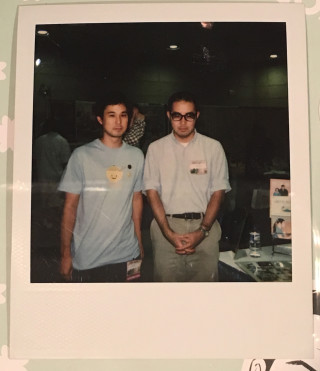 MARK: Probably more-so than any other zine, Giant Robot, has morphed and evolved over the years. When did you first decide to branch out, beyond the magazine? What were the circumstances?
MARK: Probably more-so than any other zine, Giant Robot, has morphed and evolved over the years. When did you first decide to branch out, beyond the magazine? What were the circumstances?
[right: Nakamura with cartoonist Adrian Tomine.]
ERIC: We were selling our own t-shirts and other merchandise through the zine, and it just got to be too much. We either needed to get a storage unit to keep all of our stock, or open a storefront. I think we were debating this in about 2000. We opened the first Giant Robot shop in 2001. I think the San Francisco Giant Robot store then opened in 2003. The GR2 Gallery was 2003, the New York Giant Robot store was 2005, and our Silverlake location was 2005. Oh, and gr/eats, the cafe/restaurant, was in 2003 as well. I forget the exact dates, but I think this is close. It’s a lot of businesses at the same time. I think at one time I was paying something like 8 leases, and maybe something like 35 employees.
MARK: How were you able to manage the Giant Robot empire at its height?
ERIC: In the end, it was a tough task, and definitely wasn’t perfect. But, then again, I’d like to think the height is right now or upcoming.
MARK: And what does Giant Robot look like today, in its current iteration?
ERIC: Hard to say what others see it as. I’ve heard the good and bad of it. But, for me, it’s like a project that I keep working on. It has fewer locations, but I think it’s as valuable as ever. If the magazine was still around, I’d think that would be tough to glorify since almost everything we were doing is online in some form or another.
MARK: When you started, there wasn’t really an internet to speak of. How, if at all, did the internet change things for Giant Robot?
ERIC: The internet was an equalizing force that balanced data and information, and I suppose also turned it into 140 characters morsels. Wikipedia is what we read, Amazon is where we buy things, and as for Giant Robot, there was no space for it – at least in print form. Ads, distribution, and ultimately revenue dropped each issue. The internet changed how we all lived, and print publications weren’t part of it. It got to a point where I knew no one who bought magazines – including myself and the entire staff – so why publish one? Yet, in a roundabout way, zines are back as a result of the internet. People want to touch print again – at least in certain types of doses.
MARK: Why do you think that is? Do you think people, who have grown increasingly isolated over the past few decades, are longing to for the personal connection that zines provide?
ERIC: Maybe so. It’s weird to see that zines are bigger today than ever and people are into going to zine fests and buying direct from the creators. The idea of handmade is important to people. The same thing is happening in other fields of business too. Why is it that even local chefs are getting popular? People are into the idea of having a relationship with who they are consuming things from.
MARK: What advice would you give to people starting zines today?
ERIC: Have fun with it. That’s the main thing you should expect with zines. Getting a response is the next step. I suppose my actual advice depends on what the intention is.
MARK: Was there some point that you stopped identifying Giant Robot as a “zine”?
ERIC: Perhaps something like the 10th issue. I think the glossy cover did it.
MARK: Did your mindset change at all, once you started thinking of Giant Robot as a magazine… as a business? Did you find yourself, for instance, choosing stories for different reasons?
ERIC: Not too much at that point. I think it was still pure, but I think the design is what changed a lot. I suppose at the time zines were seldom well designed. We were bad until we got a great designer.
MARK: Over the last several years, you’ve been curating a lot of big art shows. How did that come about?
ERIC: I’d like to think that all of the creativity in coming up with abstract ideas for articles, sifting through products and buying for the stores, and problem solving business issues led me to curating art. I opened GR2 Gallery in 2003, and placed the artists and art that I liked on the walls. It was trial by fire. It worked and I’m still doing it, and I’m still buying for the stores as well.
MARK: Tell me about the Giant Robot Biennales.
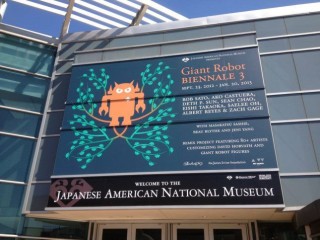 ERIC: Art shows. Big ones at the Japanese American National Museum. We’ve now put together four, and the latest was the second largest exhibition opening night in their building. They’re all different, and I hope each stands out from the other.
ERIC: Art shows. Big ones at the Japanese American National Museum. We’ve now put together four, and the latest was the second largest exhibition opening night in their building. They’re all different, and I hope each stands out from the other.
MARK: I read somewhere that one of the artists in the most recent biennale, Yumi Sakugawa, grew up reading indie comics at one of the Giant Robot stores. It must be gratifying to know that you had a hand in inspiring young people who are now creating interesting art themselves.
ERIC: She’s a great zinester. Yumi Sakugawa, in my opinion, is one of the leaders of the Asian American scene in LA… That’s a strange thing to say… That’s one reason to have her in the current GR Biennale. I wanted to represent zines in some way, and I’m glad to have done it.
MARK: How do you keep finding good, interesting artists? Or, at this point, given your position in the LA arts scene, do they find you?
ERIC: I have to look and research. They can’t just be good, they sort of have to fit my own personality in some way. It’s hard to work long term with someone that you don’t get along with. It sounds strange, and contrary in business, but I’d feel bad if I don’t do my best for an artist so it’s best if I really liked their work and liked them too. In the end, it’s also a personal investment.
MARK: Did the Giant Robot crew ever make their way through Baltimore? I was just talking with someone from there who seems to remember you as being “gangsterish badasses,” like “guys out of a Tarantino film.”
ERIC: That’s come up recently. I heard at the first Biennale exhibition in 2007, we were dressed like the “Reservoir Dogs.” As far as Baltimore, I’ve been a few times, but maybe they have me mixed up with someone else. I don’t remember any “gangster” incidents while I was there. Sounds like a great myth though.
MARK: What does the future hold for Giant Robot?
ERIC: It’s hard to answer this one. I was never good at making a five year plan. In fact Giant Robot never had such thing. It went from hobby to career without much planning. Thankfully, “things” come up, and since my work is flexible, I can pursue things as they appear. I think this is how it’s been for the last 21 years. I’m more into the current than the past and the future.
MARK: Do you foresee there ever being a new issue of Giant Robot?
ERIC: Could be, but I don’t plan on it right now. I made a newspaper sheet, two sided for the latest museum exhibition and doing that alone was quite tough. Maybe a new issue would have to take a much different form. Maybe it’s photos or art only. I’m not sure, but I’m open to it.
MARK: Is there anything you would have done differently if given the opportunity?
ERIC: Yes, there are many things, but I don’t get into regretting things. But I can wish, right? Perhaps the magazine needed to close earlier and it would have been nice to have planned the ending too. I wish I worked in the shops prior to 2010 or 2011. I can’t remember when I started working there, but it’s been a great job. The more I think about this question, I can also think of negative things that I wish I could fix like the distribution troubles, but it’s not going to help by talking about it. I suppose that’s the live and learn part of my career. I’m hoping I learned.
[above: Photo of Eric Nakamura by Gina Ferazzi on January 15, 2013 for the LA Times.]
[note: If you like what you’ve read and want more about the American underground press and the people behind it, be sure to check the other interviews in the History of Zines series.]

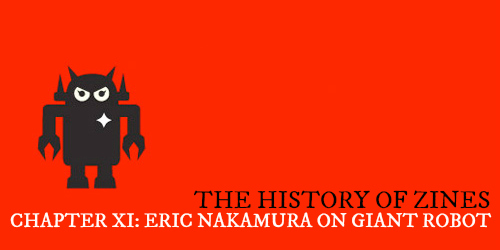
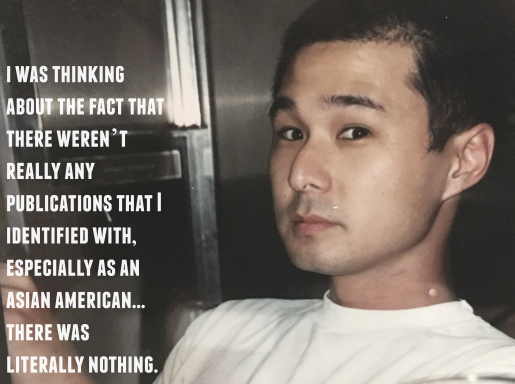

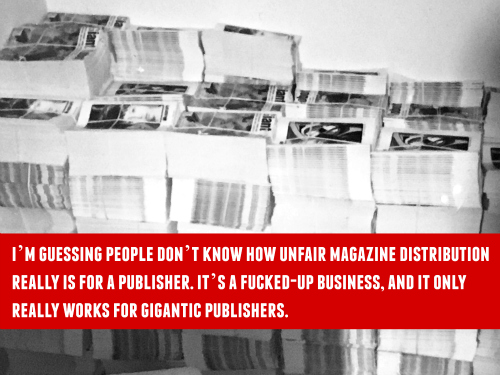








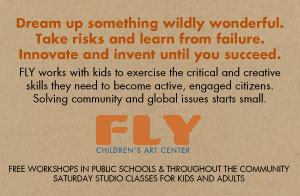



13 Comments
“You also get paid something like 210 days once the off sale date has kicked in. So, basically, you get paid something like 9 months after you paid for the printing and shipping – with so many little fees added in. It’s fucked up gangster shit. Then, you find out that your distributor, who hasn’t paid you for maybe four or five issues (if you were bi-monthly), went out of business, and now you’re not getting paid at all. It’s what killed Punk Planet.”
This is what running a record label was like in the 90’s and early 00’s. It was absolutely pointless. It didn’t help that the distros were run by people uninterested in the products they sold.
For a brief second in 92,93,94 distros were somewhat dependable, but then shit just went downhill.
I liked Giant Robot. Glad to see this.
Of course, people who have never run a record label will accuse me of negativity.
I say to them, try putting out records you believe in and working to do the best you can for bands you believe in, and then have distributors and stores fail to pay you.
All the belief in the world won’t keep a band fed on the road, and won’t pay their rent when they get back.
People have this romantic notion that bands should sacrifice everything for their art, but when you look around the structural and financial issues are what keep talented people from pursuing their craft past 22 years of age.
And that’s really sad to me.
But I shouldn’t say anything at all. Fuck life.
I never knew that the Giant Tobot empire extended so far beyond the zine. I’m enormously impressed by what Eric continues to build from that original foundation.
It’s great to learn the story behind an old favorite. It you ever talk with Nakamura again, please ask him about the Scion xb Famicom Car he designed for the Japanese American National Museum.
The guy survived the restaurant and the magazine business, and he pulled out a career. Impressive. I like him. He’s honest about what worked and didn’t work. He keeps going on. His focus on staying in the present, remaining flexible and open and not committing to a future strategic plan was very interesting. This tends to be my way and I have drifted from that or felt bad about it recently, but it works for me. It makes for an interesting life, if not an entirely stable one. It definitely keep you on your toes. This was a great read, maybe even a necessary on for me right now. thanks.
Good article. I guess I’ve been influenced by Giant Robot, even though I didn’t know it at the time.
Fascinating!
There have not been many comments on this post.
None in Japanese yet, though.
People only like comments which make them feel powerful at home.
Simply stating that a magazine was good and worthwhile does not make people feel powerful at home.
I’m lucky to have discovered Giant Robot with issue #8, and I was a fan of the magazine until the very end. To this day, in fact, I still find it a bit sad still when I go into Barnes & Noble or the comic book shop and walk over to the magazine rack, knowing that there’s no new issue of GR to be had. But I’m proud to be able to say that the first issue of my own zine was reviewed in issue #37 of GR, and that an essay that I wrote with the magazine in mind was published in issue #64.
Thanks for the comments. The interview is a fun one thanks to the questions and persistence of Mark and thanks to the LA Zine Fest for the promo of it. It had a lot of shares there! Hopefully it uncovers just a bit more of how it was at the time.
Giant Robot is going online.
http://giantrobotmedia.com/
2 Trackbacks
[…] Eric Nakamura of Giant Robot fame felt that same sting. Read more about his experience here. […]
[…] Mark Maynard, “The Untold History of Zines… Eric Nakamura on Giant Robot” (February 2016) http://markmaynard.com/2016/02/the-untold-history-of-zines-eric-nakamura-on-giant-robot/?fb_ref=Defa… (Accessed: April 13, […]